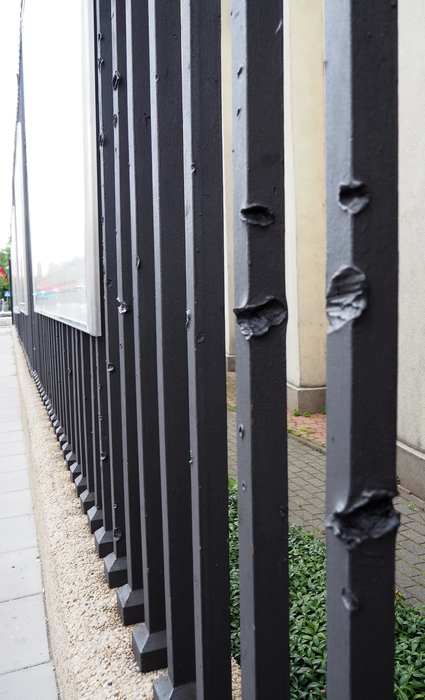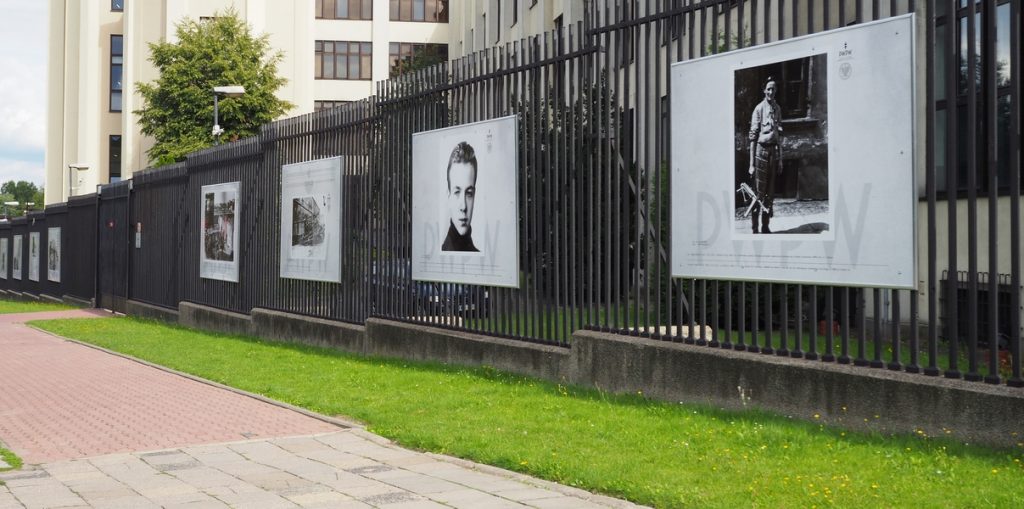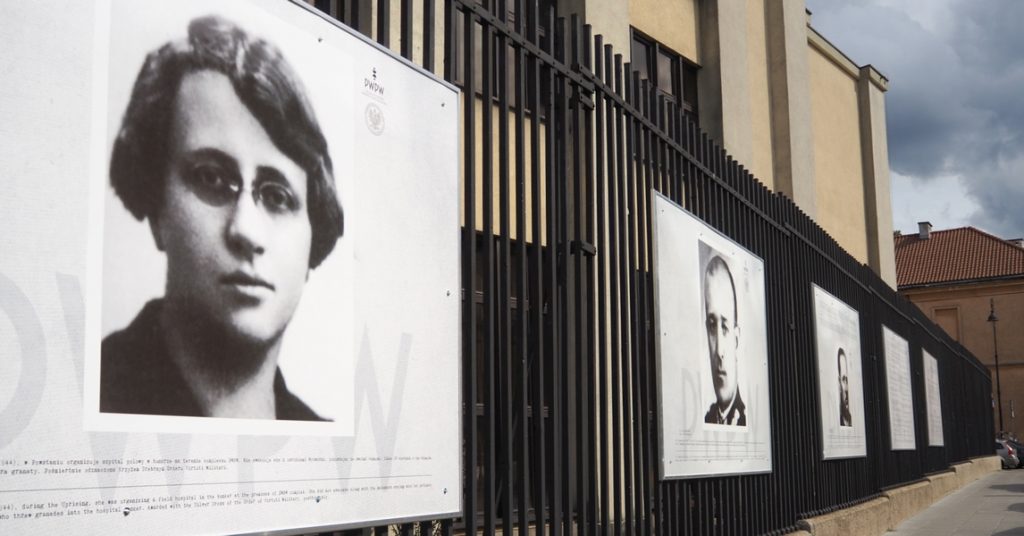Scars Left Behind
The rust stains in the low pebble-rendered walls drew me to cross the road. I saw that they were caused by the remains of shells, and that the heavy railings set into those walls were pockmarked too.

I followed the railing-wall around the corner and found the cause: The building had been integral in the 63-day Warsaw Uprising in 1944.
It belonged, and still does, to the Polska Wytwórnia Papierów Wartościowych, the Polish Security Printing Works, details I found out thanks to a series of several giant posters mounted along the railing on Zakroczymska Street, and more around the corner on Sanguszka.
I did not set out with any specific plan that day, my second in the city. I took my street map and meandered north from where I was staying just outside the Stare Miasto, the Old Town. Earlier, I had spent time at another Warsaw Uprising poster exhibition, mounted on much smaller railings outside the Roman Catholic church on the New Town market square, barely 400 metres away.
Those scars of battle gave reality to the PWPW poster exhibition. I was glad that the railings still stood, defiant and as obstinate as any Pole. I wanted to record them and their story.
I hadn’t been there long when a man, who I assumed was a security guard, appeared on the other side of the railings and asked what I was doing.
I’m a visitor, I told him in my imperfect tongue. I am Polish. I am interested in all this. It is my history. He seemed satisfied.
I am glad that I was able to turn the corner into Sanguszka and spend more time with the posters before another security guard approached me. Remove yourself, he said, not interested in my reason for being there or taking photographs of the posters. Then, I did not immediately link the PWPW logo on the posters with the building, but even if I had managed to mount an argument—Is an outdoor exhibition not meant to encourage people to stop, read, and take photographs?—I allowed myself to be bullied away. He reminded me too much of the 1970s South African security police, and I was aware of being on my own.
I was disappointed and frustrated: There were several posters I had not had a chance to get to, and I was interested in the next one. Surely he was too young to be in a commanding position. I crossed the road to the park, continued to find and photograph memorials, and made my way back to my accommodation along the river.

_______________
The candid recollections of a 12-year-old who became a theatre nurse’s assistant during the uprising, opened the way for a new menu in our War Immigrants page. The story is called Sixty-three Days and appears under 1944 Warsaw Uprising.
It reminded me of the many plaques and memorials to the Warsaw Uprising in that city, and specifically of the railings I saw on 14 August 2016.
Polish insurgents who worked at the printing works, captured them from the Germans on 2 August 1944 and, with other AK (Armia Krajowa) units, held them until 28 August. German forces supported by tanks and airplanes bombarded the buildings and pushed the insurgents to lower and lower levels. Dr Hanna Petrynowska, the PWPW’s factory doctor, had set up a field hospital in the underground shelter. Some of the surviving insurgents managed to escape, but Dr Petrynowska and her nurses refused to leave the wounded.
According to the Warsaw Uprising Museum, Dr Petrynowska was performing a surgical procedure when the Germans finally re-took the building. She told the German soldier that she would not withdraw until she had finished. He shot her dead. The remaining nurses and wounded died after Germans threw grenades into the hospital bunker.

I do not know whether the PWPW commemorates its former employees every August. I do know that I was impressed by the number of Polish and Varsovian flags I saw flying from city lampposts and all sorts of buildings.
As I walked through the castle gardens on my way back to the apartment, I was stopped by the noise and by-passes of several military jets: the Polish Air Force rehearsing for the Polish Armed Forces Day parade the next day.
I had stepped into the annual commemoration of the Miracle on the Vistula, that day on 15 August 1920 when Poles repelled the Soviets in the Battle for Warsaw, also known as the 18th Decisive Battle of the World.
—Barbara Scrivens
29 October 2021
_______________
Our full Warsaw Uprising story is available at: https://polishhistorynewzealand.org/sixty-three-days/
Information on Juliusz Kulesza from: http://sunday.niedziela.pl/artykul.php?dz=z_historii&id_art=00024
_______________
If you would like to comment on this post, or any other story, please email editor@polishhistorynewzealand.org.
